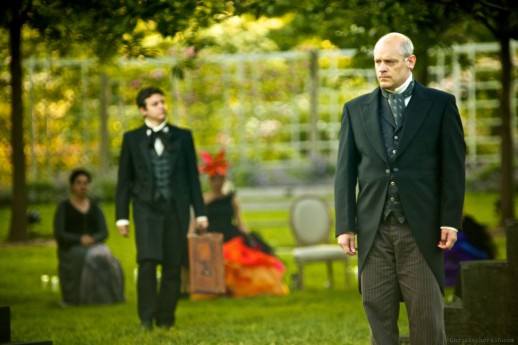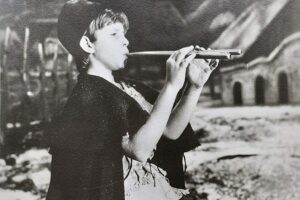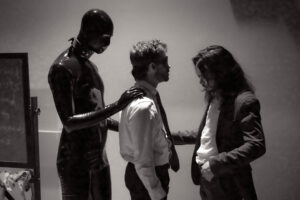

If Catán’s astringent, percussive score does not live up to such coloristic hints, the staging by Gotham Chamber Opera in the Brooklyn Botanical Gardens on Monday evening certainly did, at least in the glamorous pink and purple above the stage area, a sunset lingering precisely as long as the not-quite-two-hour score and not a second longer. Kudos to whoever arranged the clouds just so above Prospect Park. The opera will be repeated next Monday at the same site, right behind the Brooklyn Museum. Weather is predicted.
Hawthorne’s theme of science run amok, questioning (even violating) the Laws of God, was a popular one during an era when intellectual progress rashly challenged much received (and revealed) wisdom. Dr. Rappaccini sacrifices his life, his soul, his daughter, everything to the new idol, experimental science. His garden in Padua mimics Eden, except that all his exotic and selectively bred plants are poisonous. (Today, Hawthorne might call his tale “Monsanto’s Daughter.”)
The doctor’s child, evidently also self-generated, has likewise been nurtured on the poisonous garden. She has a touch that burns, a kiss that kills; the character cries out for punk diva treatment. But she has one thing she can call her own, her God-given soul, all cloying sweetness and light. The student, Giovanni, who carelessly falls in love with her, is gradually transformed by her breath and the garden’s atmosphere into her poisonous male counterpart. He gives her a “universal antidote,” but the substance that will cure any poison, kills pure, poisonous Beatrice.

The elderly housekeeper becomes more clearly a procuress. The rival scientists fight their battles in the open. But somehow, while young Giovanni is clearly presented, in his naiveté and in his sensuous self, Beatrice, too heavily, symbolically explained in Hawthorne, is a sketchy enigma here. We don’t quite get what she wants, what she knows, any clear sense of her lonely predicament. That’s the libretto; Catán’s score which, in the hands of a master would fill in the blanks or replace them with something attractive in its very vagueness, is atmospheric but insubstantial.
The music is scored for percussion: harp, piano, triangle, drums. This is metallic rather than sensuous, full of suggestion but little melody. It is not that Catán is unaware of melody or its uses in storytelling: At moments of heightened drama, such as Giovanni’s first sight of Beatrice or the trio of temptation when the doctor bids his “creations” join together in a ghastly parody of Adam and Eve and their death-bringing tree, melody seems to find itself and hearers are pleased and grateful. We receive these emotional pinnacles … well, emotionally.
But Catán either cannot or does not care to sustain melody. Most of the tale is stated in the bald arioso of so much dreary modern opera. The singers go up too high for comfort when they are upset by something, or descend when they are speaking portentously. It makes one restless to hear what they can really do, and Catán is not much interested in exploiting that resource. Too, in this outdoor performance they were all miked, which flattened emotional affect as well as undercutting any personal skill at producing loud or soft singing for dramatic reasons.
Beatriz (as she is in this Spanish libretto) is sung by soprano Elaine Alvarez, whose miked voice indicated little emotion and had trouble sustaining top notes. Far more alluring was the near-contralto of Jessica Grigg as Isabela, Giovanni’s insinuating landlady who could hardly change the towels without appearing to murmur of love, while she seemed positively to glow on the word “flores,” underlined by percussive explosions.
Giovanni was sung by Daniel Montenegro in an appropriately ardent manner: It was clear from his easy phrasing and rise to controlled anguish that his character was confronting new and startling emotions. His voice gave his feelings a meat the libretto tended not to provide. Eric Dubin’s dark baritone made Dr. Rappaccini a sturdy, almost Satanic figure in contrast to his sickly, neurotic original in Hawthorne.
Tenor Brian Downen had the thankless role of Rappaccini’s scientific adversary, Baglioni, who had to sing a lot of narrative exposition without getting much song out of it. The flowers (and what a chance Catán wasted, here, to build modern color upon the nymphs of Wagner and Strauss!) were well danced and capably sung by Ariana Wyatt, Cassandra Zoe Velasco and Nora Graham-Smith.
Conductor Neal Goren kept the story moving and drew intriguing, evocative sounds from his musicians, aided by fortuitous sunset birdsong. Rebecca Taichman’s direction was simple and clear, even spread over Riccardo Hernandez’s playing areas, which included a bedroom in an inn and a garden with a tree of dead leaves that seemed to turn golden as Justin Townsend’s light fell on them.
Photos by Richard Termine.


























Comments